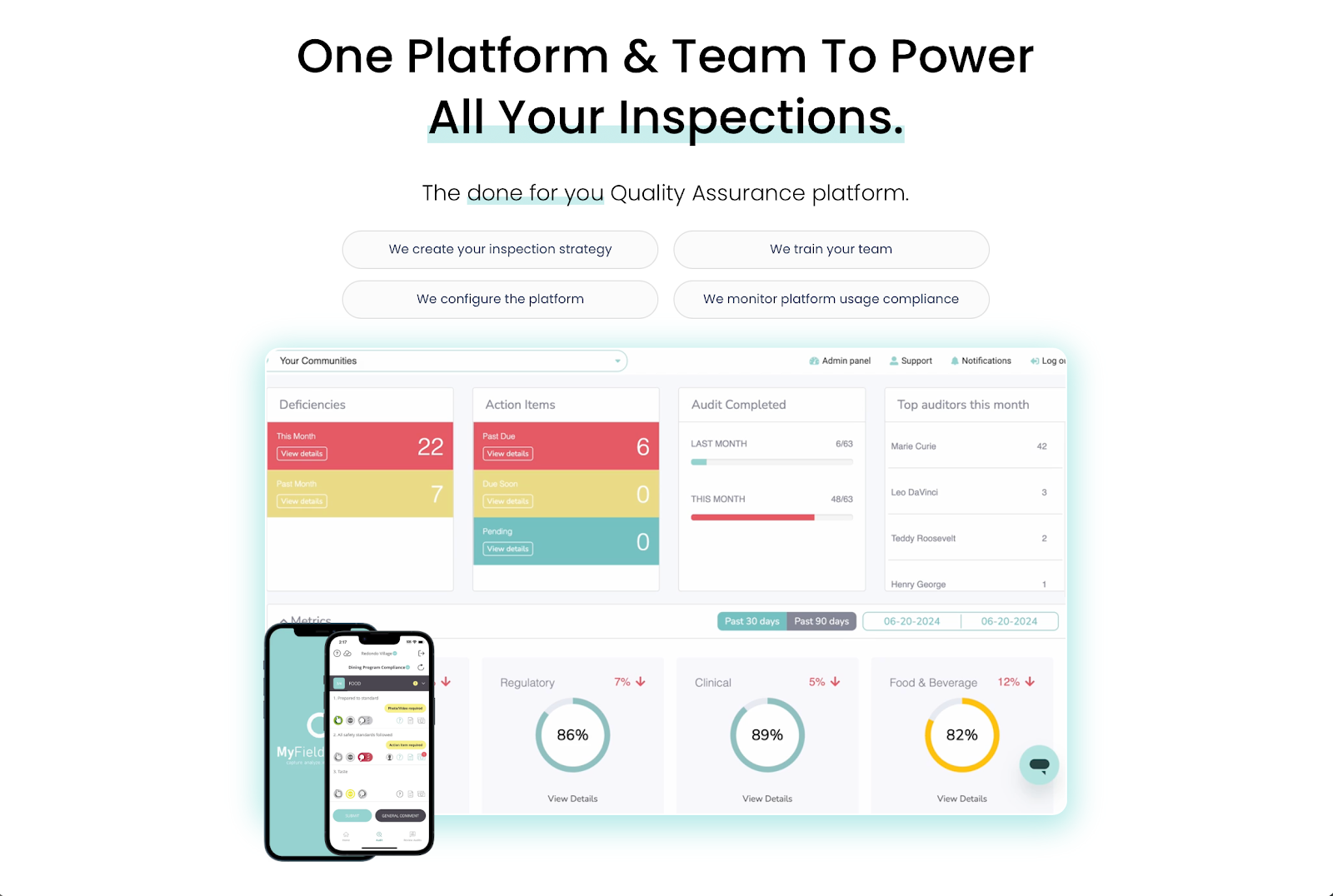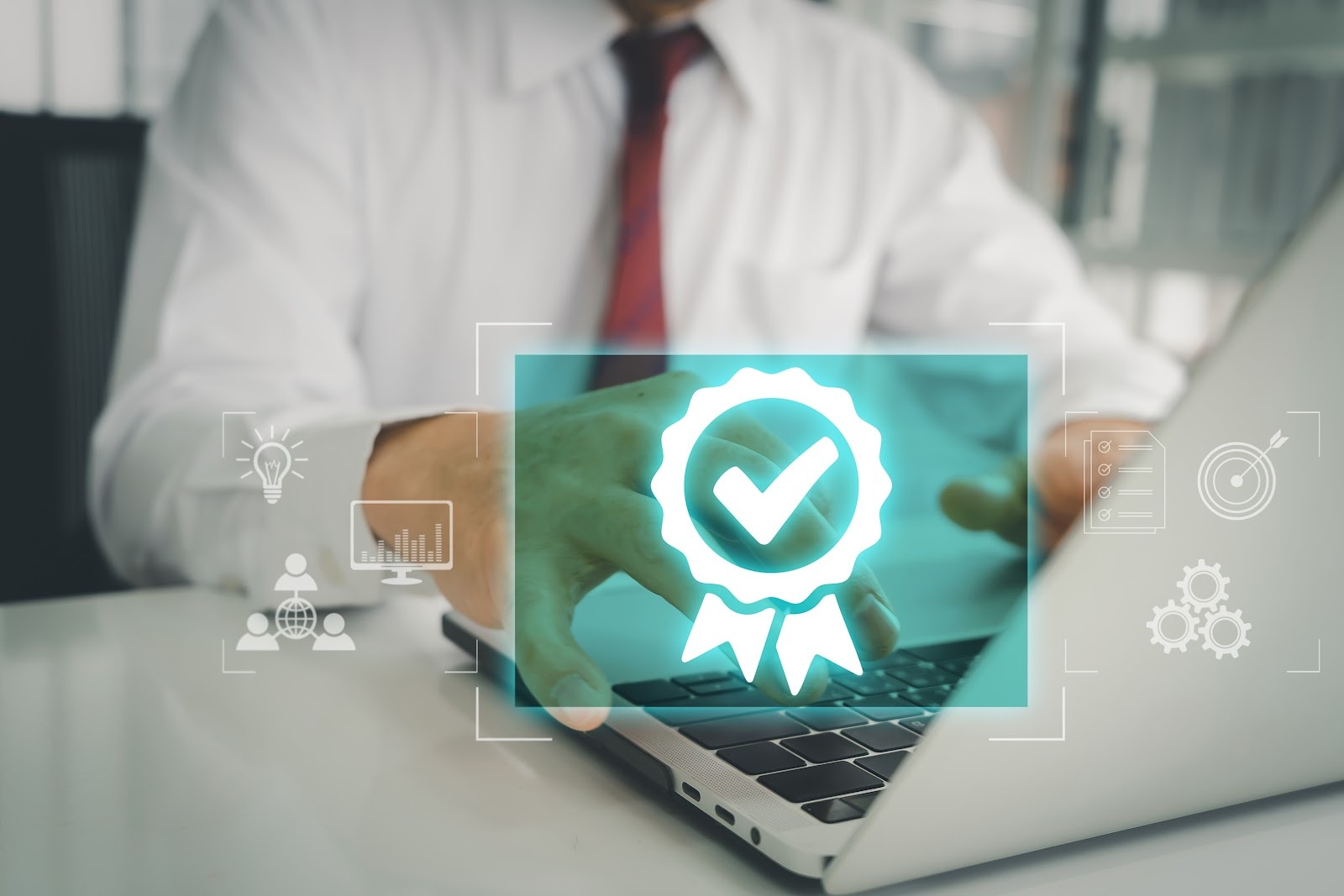.svg)
How to Create a Restaurant Audit Checklist for Compliance

Take Control of QA.
Make Inspections Effortless.

We’ll quickly uncover your needs and share how we can help—no pressure, no stress, just solutions. Grab your spot on our calendar today!
Running a food business means staying on top of different responsibilities. One of the most important and sometimes overlooked tasks is making sure your restaurant meets safety and compliance standards.
A well-structured restaurant audit checklist can make this task easier. It helps you stay organized when health inspectors visit your facility, avoid non-compliance fines, and achieve operational excellence.
In this article, we'll share five simple steps to creating an effective restaurant audit checklist. We'll also discuss the key items you should include in one.
What Is a Restaurant Audit Checklist?
A restaurant audit checklist is a detailed guide that helps you meet safety, cleanliness, and operational standards.
Think of it as a tool that makes reviewing and monitoring every aspect of your restaurant’s operations easier.
When you have a clear list to follow, you can identify gaps and determine risks before they become bigger problems.
You can maintain high food safety standards and ensure ongoing compliance. You can also confidently prepare your restaurant for inspections.
Why Do You Need a Restaurant Audit Checklist?
Check out the main reasons why a checklist is important for internal restaurant audits:
Ensure Compliance With Food Safety Regulations
When managing a restaurant, one of your biggest priorities is meeting food safety and hygiene regulations.
You want to make sure that cooked foods are stored separately from raw materials, meat is cooked at the correct temperature, and staff wear PPE, among other tasks.
Most restaurant operators often struggle to remember every detail, especially on busy days. That's due to the lack of visibility on the ground.
Fortunately, with a checklist on hand, you get a clear picture of what's happening in your food establishments across different locations.
You can significantly reduce the risk of forgetting important tasks during internal audits. You can also ensure that your kitchen, employees, and food handling procedures are always in line with health industry standards.
This helps you stay compliant with both state and federal regulations regarding food safety.
Minimize the Risk of Legal Fines and Implications
Failing to follow safety standards can cost you more than just your restaurant's reputation. It can also lead to hefty fines or legal action.
A restaurant audit checklist helps prevent these risks by making sure your business meets every regulation.
It can also generate real-time reports and other proper documentation, which can serve as proof of compliance during inspections.
Improve Operational Efficiency
In addition to keeping you compliant, restaurant audit checklists can improve your daily operations.
You can easily conduct a formal evaluation of your food premises. Review kitchen organization, equipment maintenance, waste management, staff performance, and other critical areas anywhere and anytime.
By having real-time visibility into your operations, you can quickly identify inefficiencies like faulty electrical machines or dirty floors.
You can then implement corrective actions before risks become bigger problems. Doing so keeps your restaurant running smoothly.
Plus, you can generate reports and show proof of performance with clients. No need to scramble or chase people down. You can save significant time and effort down the line.
Maintain Consistent Operational Standards Across Multiple Locations
If you own more than one restaurant, keeping all locations consistent can be a challenge.
Fortunately, a detailed checklist guarantees that every branch follows the same food standard operating procedures.
For example, you can conduct internal audits to see if all facilities store hot food at a specified temperature. You can also verify if all employees follow safe food handling practices.
You can maintain your brand’s reputation and ensure the same high standards no matter where your customers visit.
Boost Customer Satisfaction
Guests expect a clean and safe environment when they dine out. Using a restaurant audit checklist shows them that you’re committed to meeting their expectations.
Since this checklist keeps your restaurant clean, organized, and compliant, it helps you earn the trust and loyalty of your customers.
Plus, a well-maintained restaurant leads to positive reviews. These can increase restaurant sales and boost your reputation in the food industry.

Step-by-Step Guide to Creating Restaurant Audit Checklists
After understanding the importance of restaurant audit checklists, it's time to create one. You can follow the steps below to build an effective checklist:
1. Identify Key Audit Areas
Start by identifying the main areas that you need to review regularly. These typically include food safety, hygiene practices, equipment maintenance, and staff training.
You’ll also want to consider specific areas, like customer dining spaces and storage facilities.
Once you break down your audit plan into these major categories, you avoid overlooking important details.
2. Research Regulatory Standards
Next, you should research the specific health and safety regulations that apply to your restaurant's facilities. Every city or state may have different rules, so it’s important to know the requirements.
You can consult local health departments and review industry guidelines.
Alternatively, you can outsource food preparation and restaurant management by working with contract food services. These professionals are always up to date with health and safety standards.
3. Define Clear Criteria for Each Checklist Item
After identifying key areas and researching standards, you can set clear criteria for what needs to be checked during the restaurant audit process.
For example, when reviewing food storage, define the correct temperature ranges and labeling practices.
Meanwhile, under the employee hygiene checklist, you can require staff to wear personal protective equipment (PPE) and wash their hands often.
Make sure each item has specific, measurable criteria. This makes it easier for your staff to follow and for auditors to review.
4. Involve Key Team Members in the Audit Process
You should get all your employees involved throughout the entire audit process. These include restaurant managers, kitchen staff, cleaning crew, and the leadership team.
Then, assign checklist items to each department to promote a culture of compliance and build accountability.
For example, the kitchen staff should follow strict handwashing protocols and sanitize food preparation areas. Meanwhile, the cleaning crew is responsible for the disposal of waste according to EPA standards.
You can keep everyone in sync and bridge communication gaps by using a checklist.
5. Use Software to Build the Checklist
Finally, consider using food safety software apps to create a digital checklist. These software solutions eliminate the need for paper forms or outdated spreadsheets.
Digital checklists are also easy to update and accessible from any device. You can instantly see what's going on across all your restaurant locations and stay on top of food safety risks to mitigate them before they affect operations.
Plus, you can easily share results with clients and other stakeholders. You always have proof of performance ready when you need it.
What Should You Include in a Restaurant Audit Checklist?
Below are the items you can add to your restaurant audit checklist:
Food Safety
Food safety is one of the most important areas to cover in your audit checklist. A few simple checks can help prevent contamination and keep your customers safe.
- Food storage temperatures: Make sure refrigerators and freezers are set to the proper temperatures to prevent spoilage and contamination.
- Food labeling and expiration dates: Verify that all food items are properly labeled with dates and ingredient lists.
- Cross-contamination prevention: Check that raw and cooked foods are stored separately and your staff use separate utensils and cutting boards for each.
Sanitation and Hygiene Practices
Maintaining proper hygiene and sanitation can prevent the spread of foodborne illnesses. Your restaurant checklist should cover these key areas:
- Handwashing stations: Confirm if kitchen stations have enough supplies of soap, hot water, and paper towels for staff use.
- Cleaning schedules: Check that daily cleaning tasks are being completed, including sanitizing kitchen countertops and floors, to ensure facility cleanliness.
- Pest control: Make sure pest control measures are in place, like traps and proper waste disposal.
Equipment and Facility Maintenance
Regular checks of kitchen equipment and facilities can help avoid costly breakdowns and food quality issues. Consider adding these checklist items:
- Food equipment functionality: Inspect kitchen equipment like ovens, refrigerators, and dishwashers to make sure they are functioning correctly.
- Fire safety equipment: Confirm that fire extinguishers and smoke alarms are up to date and properly placed.
- Ventilation and air quality: Check that ventilation systems are working properly to maintain air quality and reduce the risk of fire.
Employee Training and Certifications
Your staff must be properly trained and certified to handle food safely and respond to emergencies. The following checks make sure everyone is up to speed:
- Staff food safety training: Verify that all staff follow food safety practices through regular audits. You should also check if they have the necessary food safety certifications.
- Emergency procedures: Train employees on fire safety and evacuation procedures.
- Proper use of PPE: Make sure all staff are using personal protective equipment, such as gloves and hairnets.
Successful Restaurant Audits With MyFieldAudits
MyFieldAudits manages the entire lifecycle of onsite inspections. Our team of experts will help you conduct audits from a mobile inspection platform.
We'll also provide real-time reports and retention-focused insights that make it easy to prove value while managing multiple locations. No more guessing or chasing people down.

MyFieldAudits goes beyond your typical restaurant audit software. We act as your retention engine.
We'll take care of platform configuration, training, and compliance monitoring for your restaurant. You can focus on fixing the real issues that affect performance.
Schedule a discovery call today to get started or watch this video to learn how MyFieldAudits can benefit your restaurant operations.
You can also contact us by dialing (844) 344-7265.
FAQs About Restaurant Audit Checklist
What does a restaurant audit consist of?
A restaurant audit checks if your business follows food safety, hygiene practices, and operational standards. It covers areas like food storage, hygiene, staff behavior, and equipment maintenance.
What are the five audit checklists?
The five key elements of a kitchen audit checklist refer to food safety, proper storage, sanitation, facility maintenance, and employee training. Each category ensures that different parts of your restaurant meet health and safety rules.
How to make a restaurant audit report?
Record all findings during the audit, including what’s right and what needs fixing. You can upload photos, comments, and scores to show examples. Then, organize the results into clear sections.
A good report can help you measure progress, address customer complaints, and guide staff toward a successful audit in the future.
How to pass a restaurant audit?
You can use a detailed checklist to help you prepare for and pass restaurant audits. You should also provide thorough training to your employees. Then, use a digital software tool to schedule audits, track progress, and get real-time reports on the ground so you can quickly fix problems.
%201.svg)






%201%20(1).svg)